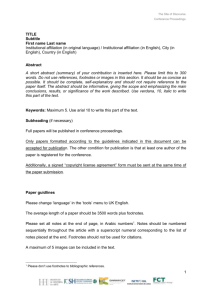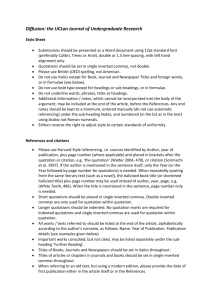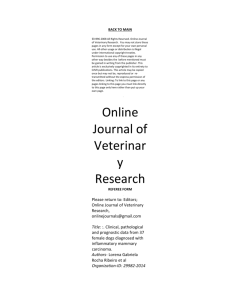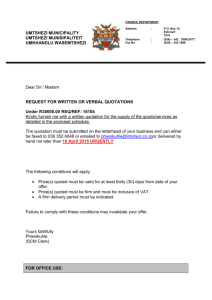SECTION C - Universiteit Stellenbosch
advertisement
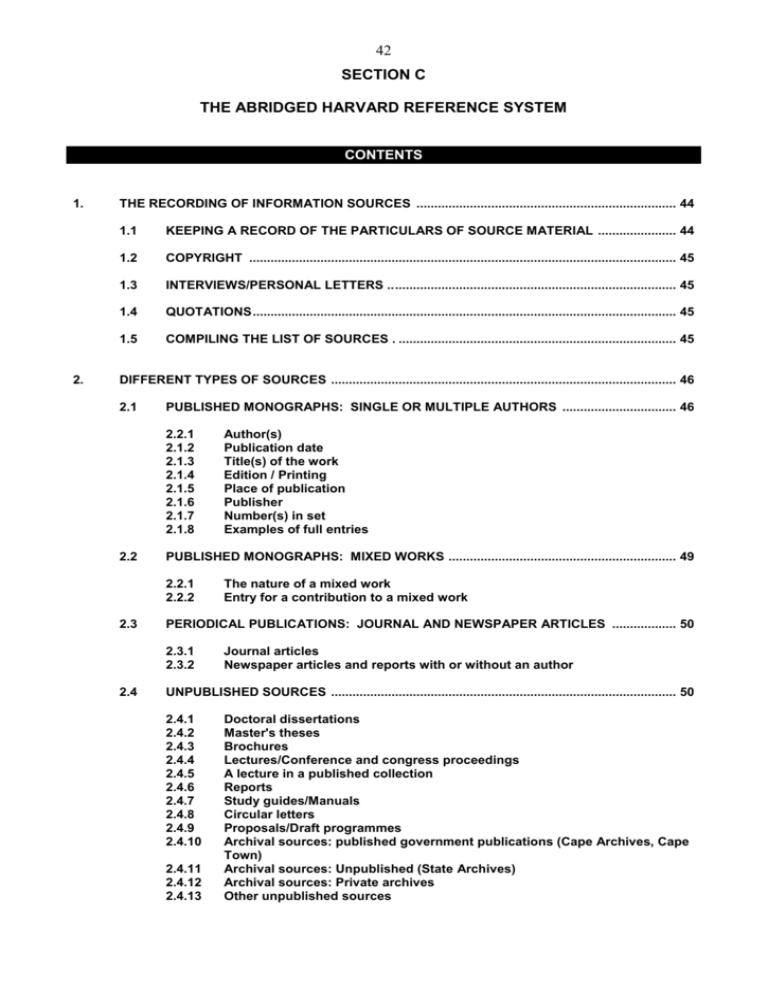
42 SECTION C THE ABRIDGED HARVARD REFERENCE SYSTEM CONTENTS 1. 2. THE RECORDING OF INFORMATION SOURCES ......................................................................... 44 1.1 KEEPING A RECORD OF THE PARTICULARS OF SOURCE MATERIAL ...................... 44 1.2 COPYRIGHT ........................................................................................................................ 45 1.3 INTERVIEWS/PERSONAL LETTERS .. ............................................................................... 45 1.4 QUOTATIONS ....................................................................................................................... 45 1.5 COMPILING THE LIST OF SOURCES . .............................................................................. 45 DIFFERENT TYPES OF SOURCES ................................................................................................. 46 2.1 PUBLISHED MONOGRAPHS: SINGLE OR MULTIPLE AUTHORS ................................ 46 2.2.1 2.1.2 2.1.3 2.1.4 2.1.5 2.1.6 2.1.7 2.1.8 2.2 PUBLISHED MONOGRAPHS: MIXED WORKS ................................................................ 49 2.2.1 2.2.2 2.3 The nature of a mixed work Entry for a contribution to a mixed work PERIODICAL PUBLICATIONS: JOURNAL AND NEWSPAPER ARTICLES .................. 50 2.3.1 2.3.2 2.4 Author(s) Publication date Title(s) of the work Edition / Printing Place of publication Publisher Number(s) in set Examples of full entries Journal articles Newspaper articles and reports with or without an author UNPUBLISHED SOURCES ................................................................................................. 50 2.4.1 2.4.2 2.4.3 2.4.4 2.4.5 2.4.6 2.4.7 2.4.8 2.4.9 2.4.10 2.4.11 2.4.12 2.4.13 Doctoral dissertations Master's theses Brochures Lectures/Conference and congress proceedings A lecture in a published collection Reports Study guides/Manuals Circular letters Proposals/Draft programmes Archival sources: published government publications (Cape Archives, Cape Town) Archival sources: Unpublished (State Archives) Archival sources: Private archives Other unpublished sources 43 2.5 FILM MATERIAL .................................................................................................................. 52 2.6 ELECTRONIC SOURCES ................................................................................................... 53 2.6.1 2.6.2 2.6.3 3. THE COMPILATION OF THE LIST OF REFERENCES .................................................................. 53 3.1 POSITION ............................................................................................................................. 53 3.2 ARRANGEMENT .. ............................................................................................................... 54 3.2.1 3.2.2 4. Internet sources (individual works) Personal email correspondence Articles or summaries on CD-ROM Alphabetical Chronological REFERENCES IN THE TEXT TO SOURCES .................................................................................. 54 4.1 REFERENCES WITHOUT QUOTATIONS . ......................................................................... 54 4.2 REFRENCES WITH QUOTATIONS .................................................................................... 56 4.3 REFERENCE TERMS .......................................................................................................... 57 4.4 CITING ELECTRONIC SOURCES ...................................................................................... 58 44 THE ABRIDGED HARVARD REFERENCE SYSTEM The Abridged Harvard Reference System, which can be used for compiling a list of references and which is recommended by the Faculty of Education, is practical, simple and time-saving. It is easy to use because footnotes are excluded. In these guidelines for postgraduate students, the Abridged Harvard System has been simplified for use by students of the Faculty of Education of the University of Stellenbosch. Because the thesis/dissertation must be word-processed before individual chapters or the whole work is presented for evaluation, the words write and type refer to this process. Note that many of the examples that are used in this section have been made up to illustrate a particular usage. (In some cases, a supervisor/promotor may prescribe the use of another reference system) 1. 1.1 THE RECORDING OF INFORMATION SOURCES KEEPING A RECORD OF THE PARTICULARS OF SOURCE MATERIAL Specific rules apply for using another person's intellectual property in your own work. All information obtained from sources and used in your own work should be carefully acknowledged, even if it is only a summary of the argument or opinions of the writer concerned. For this reason it is essential that the details of a source be accurately recorded. Punctuation, spelling and paragraph construction of a resource may not be altered if they are part of a verbatim quotation. If you do not own your own computer and therefore use a card system to record the details of the sources, write them down in such a way that they can be easily processed into a resource list later. WRITER Povey, RM. YEAR 1980 TITLE Educating the gifted NATURE OF RESOURCE Monograph Contribution to book Lecture …X….. …..…... …..…… WRITER YEAR TITLE Jansen, FD. 1998 Die skool in die nuwe millenium Article Review Report EDITION/PRINTING Second edition …X….. …..…... …..…… PLACE/PUBLISHER London: Harper & Row. ORIGIN US Library 371.95 EDU JOURNAL/NEWSPAPER/OTHER Opvoeding en Onderwys VOL/NO PP 10 (2): 12-16 ORIGIN US Library 371.95 EDU Remember to record the following particulars: Writer/compiler/editor/speaker (surname and initial(s)) Date (year of publication/day, month and year of unpublished resource, newspaper, or interview) Full title (as well as any subtitles) of the resource/subject/statute Type of edition/nature of source Volume number or month/season of issue (journals), full publication date (newspapers) 45 Origin (place of publication and publisher/name of journal or newspaper/place at which interview took place) Page numbers (for quotations/articles in journals/contributions to a collection) 1.2 COPYRIGHT All published work and any printed or duplicated work of an author other than your own is subject to copyright. You lay yourself open to prosecution if you do not acknowledge the writers whose work you have consulted or if you present someone else's work as your own. 1.3 INTERVIEWS/PERSONAL LETTERS The dates and origin of original documents, as well as the dates of interviews that are conducted in connection with the research and the names of the persons involved in the interviews, must be accurately recorded. If it is at all possible, an interview should be recorded by electronic means (if the interviewee consents to this) or a written version of such an interview should be submitted to the interviewee before being utilised in your own work. The approval of the interviewee to use the opinions or viewpoints that he/she expresses, with the necessary recognition, in your own work should preferably be obtained at the time of the interview itself. This applies also to letters that are received. Should particular topics be discussed in strict confidence, the information may be used only if the correspondent gives his/her permission. In such cases the source should remain anonymous. Use a footnote to explain this. 1.4 QUOTATIONS Quotations from published and other works should be used precisely and judiciously. Sources may be referred to as part of the text (with or without the use of quotation) after a particular viewpoint has been repeated or summarised in your own words when the writer (in this case, the student) wishes to endorse, emphasise or possibly reject a particular viewpoint. Both quotations and source references should be presented correctly and fully and in such a way that if necessary, they could easily be found again later and checked. It is essential that you be consistent in the presentation of the details of the sources. 1.5 COMPILING THE LIST OF SOURCES Although you will present your sources in a single, alphabetical list of works consulted, sources fall into the following categories: Individually published monographs (single or multiple authors) Mixed works (several authors with or without an editor) (for example, an anthology, volumes of lectures, contributions by different writers on the same topic, a collection of articles) Periodical publications (eg journal and newspaper articles or reports) Statutes and other official publications Unpublished works (printed or manuscript) (eg reports, pamphlets, information items, theses, dissertations, study guides, official and personal letters and diaries) Personal interviews Film and video material Electronic sources 46 2. DIFFERENT TYPES OF SOURCES MOST OF THE EXAMPLES USED IN THIS SECTION ARE FICTITIOUS. The List of References follows after the text. Entries begin against the left hand margin but the second line is indented (0.5mm) so that the authors' names stand out. Leave one line open between entries. Always record the details of a source in the language of the version that was used. 2.1 PUBLISHED MONOGRAPHS: SINGLE OR MULTIPLE AUTHORS 2.1.1 Author(s) One author The surname is placed first (followed by a comma), then the initial(s) (without stops) followed by a stop. When only the editor's name is given, it is treated in much the same way as a single author. Jones, CJ. Galloway, M (ed.). Author with a double-barrelled surname The surname under which the author is generally known is place first. A double-barrelled surname is retained as such. Lloyd George, D. Rice-Burroughs, E. Two authors Maintain the sequence of the names as it appears on the title page. Tally, CP & Jonathan, JW. Three and more authors The names of the authors are given in the sequence in which they appear on the title page. When only an editor's name is given, it is treated in the same way as the name of a single author. Three and more authors Gordon, J, Fraser, L & Foster, LP Editor Gordon, J (red.). = Afrikaans Galloway, M (ed.) = English Main editor with assistant editors Only the surname and initial(s) of the main editor are given. Corporate authorship (a group of people, an institution or a publisher) Use the language of the work as a guideline. Use the abbreviated form of the publisher (see par. 2.1.6) British Museum. Department of Education. Ministry of Education. Universiteit van Stellenbosch. 47 Well-known acronym as the author An acronym may be used if it is internationally known. It is always written in the language of the source text, in both the text and in the List of References. UNESCO. Abbreviation as the author If such an abbreviation is not well known, the name must be written in full in the List of References with the abbreviation in round brackets after it. The abbreviation may also be used in the text if it is used often, but is must be written in full when it is referred to for the first time in the text. Association for Independent School (AIS). No author If the author is not named, the title of the reference work is used in the place of the author's name. Forest development in South Africa. 2.1.2 Publication date Positioning Place the date (not in bold) immediately after the name of the writer, followed by a stop. Johnson, J. 1998. More than one title by the same author (different dates of publication) List the works chronologically in the List of Sources. More than one title by the same author in a particular year List the works in alphabetical order and indicate the dates as follows: Davids, N. 1996a. Davids, N. 1996b. Davids, N. 1996c. Arabic numerals Replace Roman dates with Arabic numerals. Date of publication not given Use the date of the particular printing. No publication date or date of printing Write as follows or, if the date can be found elsewhere, place it in brackets. s.j. n.d. (1997) sonder jaar (use for Afrikaans titles) no date (English) date not given in copy consulted but found in another source Designations sometimes found in lists of sources s.a. g.d. 2.1.3 = = = = = sine anno (without year) geen datum (use for Afrikaans titles) Title(s) of the work Notation Write down the title of the work (with subtitles, if any) as it appears on the title page (not the cover), followed by a stop. The title of a published work is italicised in the list of references as well as in the text (not 48 underlined or in bold). Only words that are normally spelled with a capital (beginning of sentences, proper nouns, etc.) take a capital. The spelling rules of the particular language in which the work is written must, however, be observed. Great expectations. Growing up in the Transkei: A rural childhood. Hilfe für Elternhaus, Schule und Gemeinde (title with subtitle) (a German publication) Titles in foreign languages If the language of the title is unknown to the target audience, a translation of the title may be placed in brackets after it. The translation of the title both in the text and in the list of references must, however, not be italicised. 2.1.4 Edition/Printing A second or further edition indicates a reappearance of the work with changes to the contents or layout. The edition statement is inserted after the title, followed by a stop. A further printing is a re-issue of the original work (or a further edition of it) without changes. Notation The edition is indicated only if it is not the first edition, followed by a stop. It is not written in bold or italicised. Second edition. The date of publication may also be indicated as below. The date between brackets indicates how old the original work really is. 19976 (1980) = sixth printing of the 1997 edition of the original 1980 publication 2.1.5 Place of publication Notation The name of the place is written in the language of the publication, followed by a colon. Oos-Londen Brussel - and not East London; as for an English publication Dutch source, therefore not Brussels (=English) More than one place with the same name/name unknown The place name is followed by the name of the larger geographic area if the place is not well known or if the same place name occurs in more than one country. Worcester, England: Place not indicated Use the following abbreviation (see also par. 4.3) s.l. 2.1.6 = sine loco = without place Publisher Notation The name of the publisher may be shortened to a still understandable or identifiable form, followed by a stop. Omit the words Uitgewer(s)/Publisher(s) or Press/Pers if they are not necessary. Hodder & Stoughton Tafelberg Wiley = = Tafelberg Uitgewers. John Wiley & Son, Inc. 49 Harrap = George G Harrap & Co. Publisher's name not provided Use the following abbreviation. s.n. 2.1.7 = without name (sine nomine) Number(s) in set Notation Set numbers are place after the title of a work in round brackets, followed by a stop. (2). (Deel 2). (Vol 2) 2.1.8 = Afrikaans editions Examples of full entries One author North, PJ. 1973. People in society. London: Longman. Two authors Lewis, AJ & Miel, A. 1972. Supervision for improved instruction. Belmont, California: Wadsworth. 2.2 PUBLISHED MONOGRAPHS: MIXED WORKS 2.2.1 The nature of a mixed work A mixed work (collection) is a separately published monograph, but the contributions of different authors may be identified in it. Mixed works usually consist of contributions that have been prepared for a specific occasion or purpose (such as a symposium, an anthology, to honour someone or on a particular theme) and afterwards published as a unit. 2.2.2 Entry for a contribution to a mixed work Take note of the example below. The title of the contribution is not italicised but that of the unit/collection is. The title is written in this way in the list of references as well as in the text (if the contribution or work is named specifically in it). Because this source is part of a larger whole, the pages are indicated. The page numbers are preceded by a colon, which follows the name of the publisher. List of References: Popitz, H. 1972. The concept of social role as an element of sociological theory. In JA Jackson (ed.), Role. Cambridge: Cambridge University: 1130. Text: Popitz (1972: 12) refers to similar works in the authoritative work by Jackson. Editor Note that the usual sequence of the name of the editor or compiler is used here, followed by a comma. J Hattingh (red.), R Campbell (ed.), L Wright (comp.), J Compion (ss.), = = = = Afrikaans English compiler samesteller (English: compiler) Date of publication The date of publication of an individual contribution may differ from that of the mixed work, especially if the latter is a compilation of earlier articles or lectures. Both dates should be given. Pagination 50 Full page numbers should be given, followed by a stop. 126-129. 2.3 not 126-9. PERIODICAL PUBLICATIONS: JOURNAL AND NEWSPAPER ARTICLES 2.3.1 Journal articles Take note of the example below. Passow, AH. 1981. The nature of giftedness and talent. Gifted Child Quarterly, 25(1): 5-9. Author(s) Author's names are written just as for a monograph (single or multiple authorship). Date of publication The year of the journal/newspaper is followed by a stop. Title of article The full title is given, but it is not italicised, written in bold or underlined. Title of journal/newspaper This is entered in the form in which the journal/newspaper has been registered, followed by a comma. The title is italicised in both the list of sources and the text. Tydskrif vir Wiskunde en Wetenskap, Mathematical World, Volume and part numbers Arabic numerals are used for volume and part numbers or, if applicable, the name of the month (abbreviated) or season of the year (both in the language of the journal) as used, followed by a comma. If both volume and part numbers and a month/season are given, only the former are used. 8(6), November, Summer, - not vol 8(6) - or Somer (=Afrikaans) Page numbers Page numbers should be given in full, followed by a stop. 183-185. - not 183-5 2.3.2 Newspaper articles and reports with or without an author If the writer's name is not given in the magazine or newspaper article, the article is referred to by its title. In the List of References the title is listed alphabetically using the first word. If the work is referred to in the text, the name of the journal or newspaper, the (full) date and the page number(s) are provided. Mense kan nie meer reg praat nie. 1986. Die Burger, 28 Mei, 8. Millenium mania. 1999. The Chronicle, 3 June, 11. Scholtz, RK. 1995. Fratricide in Indonesia. International Perspectives, 26 November, 12. 2.4 UNPUBLISHED SOURCES Unpublished sources include computer printouts, typescripts or manuscripts. The titles of these sources are not italicised in the text or in the list of sources. Study the examples below. 2.4.1 Doctoral dissertations 51 The full title on the title page and the formal name of the degree are given. Note that some dissertations may be published, usually by the university from which the degree was obtained. In this case the thesis is treated as a monograph and the title is italicised. Baard, ML. 1998. Expressive movement and the perceptual-motor development of young children from disadvantaged communities. Unpublished PhD dissertation, University of Stellenbosch, Stellenbosch. Carinus, AA. 1992. Waardes in 'n multireligieuse samelewing. Ongepubliseerde PhD-proefskrif, Universiteit van die Oranje-Vrystaat, Bloemfontein. Johnson, JK. 1980. Christian values in a secular society. Unpublished PhD dissertation, University of Rhodes, Grahamstown. 2.4.2 Master's theses Hahn, C. 1994. The evaluation of a multicultural programme. Unpublished MEd thesis, University of Stellenbosch, Stellenbosch. Jansen, AB. 1999. Vakkeuses in multikulturele skole. Ongepubliseerde MEd-tesis, Universiteit van Wes-Kaapland, Bellville. 2.4.3 Brochures A brochure usually lacks an author. In this case the origin is used as the author. The title is not italicised. University of Toronto, Canada. n.d. Student teaching. Brochure. 2.4.4 Lectures/Conference and congress proceedings In the case of the second example the lecture was prepared and presented in 1975 but the proceedings were compiled only in 1976. The name of the congress and the place where it was held are followed by a comma, and the date is given in full. The collection was not published and therefore the title is not italicised. Gous, SJ. 1971. Opvoedingsteorie en –praktyk. Referaat, SAVBO-kongres, Port Elizabeth, 22-25 May. Renson, R (ed.). 1976. The history, the evolution and diffusion of sports and games in different cultures. Proceedings of the 4th HISPA Congress. Louvain, Belgium, 1-5 April 1975. 2.4.5 A lecture in a published collection Now the title is italicised and the place of publication and the publisher are placed at the end as in the case of a monograph. Note where the page numbers are inserted. Rees, R. 1975. Organization of sport in nineteenth century Liverpool. R Renson (ed.), The history, the evolution and diffusion of sports and games in different cultures. Proceedings of the 4th International HISPA Congress (pp. 56-70). Louvain, Belgium. 1-5 April 1975. Brussels: BLOSO, 1976. The author wrote the lecture in 1975, it was given at a congress in 1975 but the collection was published only in 1976. 2.4.6 Reports Education USA. 1970. A symposium on the training of teachers for secondary schools. Report. Ou Mutual. 1999. Jaarverslag/Annual report. The organisation or institution is in this case the author of the work consulted. 52 2.4.7 Study guides/Manuals Hoffmann, PAE. 1998. Inleiding tot die sosiale pedagogiek. Studiestuk, Universiteit van die OranjeVrystaat, Bloemfontein. University of Chicago, USA. 1988. Directions and suggestions to students. Study guide. 2.4.8 Circular letters Wes-Kaapse Onderwysdepartement. 1995. Voorligting in verband met skoolgelde. Omsendbrief J222, Kaapstad, 18 Julie. Western Cape Education Department. 1996. Circular K300. Cape Town, 3 September. 2.4.9 Implementation of outcomes-based education. Proposals/Draft programmes Teachers' College, Columbia University. 1990. Training instructional leaders in a multi-agency field center. Draft programme. 2.4.10 Archival sources: published government publications (Cape Archives, Cape Town). The reference to the source should include the archival shelf reference as well as the date and page numbers of the resource (if applicable). Resolusies van die Politieke Raad. 1681-1707. C.6, Deel III. Acts of the Provincial Administration, Cape Province, 1966. D.7. Part II. 2.4.11 Archival resources: Unpublished (State Archives) Onderwysdepartement. OR 8836/96, band no. 108, 1896. Education Department, Cape Province. JK 4443/62, band no. 203. 224. 2.4.12 Archival resources: Private archives Official items such as minutes, annual reports, deeds, contracts and other items that have to be preserved fall under these. The nature of the resource and its date and origin should be indicated. Primary School Alexander. Umtata. 1996. Minutes of Staff Meeting. 22 March. Hoërskool Laelande, Cradock. 1998. Notule van Bestuursvergadering. 18 Augustus. 2.4.13 Other unpublished sources Full details of government publications (such as brochures or circular letters), personal letters, interviews, dairies, scrapbooks, photos, pictures and other sources should be given if they are referred to in the text. The following information is important: Name (surnames and initials) of the person/Origin Numbers (circular letters/statutes) Dates (letters/interviews and, if known, of photos) Place of origin (interviews/photos as documentary evidence) Sheldon, B. 1999. Personal interview. Stellenbosch, 16 March. 2.5 FILM MATERIAL Films, videos or microfilms are placed alphabetically under their titles in the list of references. Note the notation and punctuation. The names of these sources are usually registered. The Stroke Patient 1969 [filmstrip]. Costa Mesa, California: Concept Media. Valley Forge 1972 [motion picture]. New York: Steve Krantz Productions. Encyclopaedia Britannica Educational Corp. Released by 53 2.6 ELECTRONIC SOURCES There are electronic indexes, which students may use. Ask for help at the inquiries desk at the JS Gericke Library. Usually the index has a reference to the original work. If the source is not available in South Africa, the index may cite an alternative. Always keep a copy of information obtained from the Internet because web pages change from time to time and also disappear. Note that no stop is place at the end of email or Internet addresses while the resource can be traced by computer. The stop at the end of the address in the following addresses is a punctuation mark. 2.6.1 Internet sources (individual works) Try to obtain the following information: Author Year Title of subject (in quotation marks) Title of web page (italicised) Date of last revision (day and month) Availability (network information/in [ ]) Date of search (day, month and year) Ackermann, E. 1996. "Writing your own web pages." Creating web pages. 22 October. Hyperlink [http://www.mwc.edu/ernie/writeweb/writeweb.html]. 20 June 1999. 2.6.2 Personal email correspondence Author/Sender Year, month and day Sender's email address (in [ ]) Title of message (in quotation marks) Nature of medium and receiver's name Availability: Receiver's email address (in [ ]) Salter, MA. 1997, 20 May. [msalter@uwindsor.ca] Play patterns of the Bushmen children. Private email message to F van der Merwe [fjgvdm@maties.sun.ac.za]. 2.6.3 Articles or summaries on CD-ROM The following details must be given: Author Year Title of article Title of journal and medium (with its references) Availability: Resource and tracing number Burke, J. 1992. Children's research and methods: What media researchers are doing. Journal of Advertising Research [CD-ROM], 32, RC2-CR3. Available: UMI File: Business Periodicals On disc. Item: 92-11501. 3. 3.1 THE COMPILATION OF THE LIST OF REFERENCES POSITION The list of references is begun on a new page, inserted just after the last page of the text, and numbered continuously with the text. Each entry is written in single spacing with a line space between each reference. The second line of an entry is indented (0.5mm) so that the surname stands out slightly. 54 3.2 ARRANGEMENT References are arranged in two ways: 3.2.1 Alphabetical All the sources are presented in a single alphabetical list according to the author's surnames and initials unless the supervisor/promotor decides on another arrangement. 3.2.2 Chronological All the works of one particular author are arranged chronologically from the earliest to the most recent work. The works of a particular author that appeared in the same year are also arranged chronologically but are distinguished by small Roman letters: Mcawe, M. 1990a. Mcawe, M. 1990b. Mcawe, M. 1990c. 4. REFERENCES IN THE TEXT TO SOURCES References indicate the sources of the quotations, opinions, viewpoints or information in the text that are not your own. Works of authors are also placed chronologically in the textual references because often the most recent work of a writer is the culmination of long-term research on a particular subject or reflects development within a particular viewpoint. There are in particular two types of references: General: The author's name and the date of publication are given without any page references. The reference is often a summary of the writer's overall argument, approach or point of departure as derived from a longer source. Specific: The author's name and the date of publication are given with page references. The citation refers to statements that precede and follow it. The citation may also be supported by a quotation from the reference work. Examples of references are provided below. The distinguishing characteristics are indicated in each case. Quotations from reference works should be used judiciously. They should make an intrinsic contribution to your argument and should fit into the text logically and grammatically. 4.1 REFERENCES WITHOUT QUOTATIONS The date of publication and the page number (if relevant) are given in the text. These are placed immediately after the name(s) of the author(s) in the text. Note whether brackets are used or not. Within brackets there is no comma after the author's name and there are no spaces between the year, the colon and the page number(s). Page numbers are omitted if the text is a summary of the author's argument in the source as a whole, but they must be cited where a particular page or pages are relevant to your argument. Note the use of the semi-colon in the third example. Study the following examples: A general or summarising reference without a quotation This is presented without page references. 55 Jones has investigated thoroughly in several studies (1980, 1981, 1983) the influence of the family on the delinquent child. No quotation but the reference is quite specific Barnes and Todd (1977:331-332) consider that there are certain disadvantages related to homogeneous groups. (Here the authors' names are part of the text.) This viewpoint is maintained by various writers (Barnes & Todd 1977:340; Foster 1981:50; Jones 1980:50; Jonathan 1982:13). These events are singled out as the turning point in X's athletic career (Jonathan 1980:10). One author/one or more works/specific reference The particulars of the works are separated from one another by a semi-colon. Note also that the references in the second example are arranged chronologically because they refer to works by the same author. Jones (1996:12) criticises this viewpoint of Auden (1996:6). This viewpoint is emphasised throughout by Jones (1980:50; 1981:2; 1983:4; 1996:12). Two authors / a single work The & sign is not used in the text itself, only within brackets (in the text), and in the list of references. Jones and Jones (1988:23) criticise this viewpoint. Tally and Jonathan (1982:27) criticise this viewpoint. This viewpoint is criticised by the writers (Tally & Jonathan 1982:27). Two or more authors / different works Note that the authors' names are arranged chronologically according to the publication dates of the works. This viewpoint is also criticised by researchers (Jones 1996:12; Paterson (1977:20). Cloete (1992:23), Jones (1996:96) and Kennedy (1997:22) all criticise this viewpoint. More than two writers / same work First reference Clark, Hawkins and Shaw (1980:30) criticise this viewpoint. Jones, Jonathan, Blake and Wallace (1984:10) criticise this viewpoint. Further references Clark et al. (1980:50) also mention this change. Jones et al. (1984:40) launched a follow-up inquiry to test the conclusions of their first Inquiry. Mixed work (reference to a contribution) Lawson (1996 in Klatsow 1996:33) criticises this viewpoint. Statement/quotation found in a work other than the original Knowles (1994 quoted in Johnson 1997:70) criticises this viewpoint. Two authors with the same surname but two different works The works are placed chronologically. Both writers (Jones, MB 1982:20; Jones, CW 1983:11) criticise this viewpoint. Writers whose works were all consulted on a particular topic (arranged according to publication date) 56 This viewpoint of Kelly (1993:10) cannot be accepted according to Scott (1994:11), Johnson (1996:20), Thornton (1997:12) and Graig (1998:30). Various writers (Davidson 1989:11; Bailey 1994:20; Tomlinson 1996:12; Graig 1998:24) dispute this proposition. Other authors UNESCO (1980:12) is also critical of this proposition. Some research (Johns Hopkins University, USA 1984:10) indicates that pupils with handicaps benefit from being taught in ordinary schools. Author = name of institution that is abbreviated Even is it is well known, always write the name of the institution in full (with the abbreviation in brackets afterwards) when it is referred to in the text for the first time. Thereafter use only the abbreviation. 4.2 REFERENCES WITH QUOTATIONS Quotations are used especially to strengthen or support a particular viewpoint, to analyse critically or to elucidate or emphasise a proposition. A chain of quotations is undesirable and generalities (or generally accepted truths) should not be quoted at all. Quotations from works must be used either with quotation marks or italicised (not both). Foreign language words may also be indicated in the text in this way. Look carefully at the following examples (remember a quotation may sometimes be indicated by italics): A whole sentence as part of your own sentence The quotation is always introduced by a colon at the end of your own sentence and closed by quotation marks before the stop. In the words of De Vries (1979:9): "Leadership does not develop from averageness". Using a sentence in the original text as part of your own sentence The use of brackets indicates that the capital letter has been changed to a small letter. The ellipsis at the end indicates that the sentence in the original work was continued. Therefore many pupils fear "[t]he teacher who rules by intimidating people…" (Jameson 1988:30). Changing the word order of a quotation or inserting word(s) to fit your sentence construction Although most teachers agreed with this, others felt that "nobody [is] above the law" (Jones 1980:40). Quotations of extraordinary length or importance A quotation of more than three to four lines is treated as a separate paragraph, indented on the left (or on both sides) and typed in single spacing. Jonathan (1980:10) is particularly critical of this view: There has been………………………………………………………………………………………………. …………………………………………………………………………………………………………………. …………………………………………………………………………………………………………………. …………………………………………………………………………………..……..eventually collapsed. The long and complete (and thus emphasised) quotation (a sentence or a few sentences) is closed at the end of the sentence – after the stop. It is usually introduced by a sentence that ends in a colon. This introductory sentence must flow logically from the previous paragraph or section of a paragraph. Look at the examples below. Note that the introductory sentence indicates the status of the long quotation. 57 Johnson (1988:30) argues on the basis of this: ….. Kelly (1993:20) offers comment on this statement: ….. Lategan (1995:14) supports this viewpoint: ….. Hulsamer (1997:55) emphasises the reasons for this: ….. offers an explanation for this: ….. contests this: Omissions and insertions (interpolation) Omissions (of words, phrases or sentences) are indicated throughout by an ellipsis, thus … . Insertions are placed between square brackets [ ]. Inaccuracies/errors in the original text Errors in the original text that you are quoting may be indicated by [sic] just after the word/error. Own initial (italicising or underlining) Words or phrases of quotations that you wish to emphasise are indicated by initials. Indicate the change in this way: According to the Jooste Report (1998:22), many of the assumptions regarding giftedness are made on the basis of "inadequate data, partial information, and group tests of limited (underlining: CDP) value". Quotations from journals/newspapers Journal titles are not given in textual references, only the name of the author of the article/report. If no author is given, the title of the article or newspaper report is used as the author. 4.3 REFERENCE TERMS Reference terms are sometimes used in the text but mainly in footnotes. Preference is always given to English abbreviations if the text is written in English. The reference terms below are generally accepted: Abbreviations that are italicised because they are borrowed from a foreign language. Latin cf. et al. (sic) In an English text compare and others (sic) = error in the original Abbreviations that are not italicised because they are already accepted in English p. / pp. vol s.a. s.l. s.n. = = = = = pagina(e) volumen sine anno sine loco sine nomine = = = = = page(s) volume without year without place without name Abbreviations are never used in the text, only within brackets. The only exceptions to this are the titles of people, well-known acronyms and, if used repeatedly in the text, the abbreviations of the names of organisations or institutions, and then only after they have been written out in full the first time. In the latter instance the writer must indicate in a footnote that the abbreviation will be used in the rest of the thesis/assignment/ or dissertation. 58 Other reference terms Consult your supervisor/promotor about the reference terms below which you may come across in reference works. The use of the English equivalent is preferred in a thesis/dissertation written in English. infra supra vide 4.4 = = = below (e.g.: vide infra = see below) above (e.g.: vide supra = see above) see (e.g.: vide par 6.1) CITING ELECTRONIC SOURCES Appendix B



